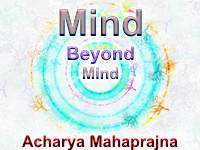
Japa is the fourth essential item in Sadhana. It strengthens the first three. It provides a new direction to the employment of vigour. It influences physical as well as spiritual energy. Normally we tell beads and recite the Namaskara Mantra. This Japa may be continued but with one modification. The Namaskara Mantra has five parts. The first is Namo Arihantanam. You have to recite this part over and over again. You may do so, but do not recite it during breathing periods, neither during inbreathing (Puraka) nor during exhaling (Recaka) but during the interval between two breathings (Kumbhaka). Recite Namo Siddhanam during the next interval. You may recite these parts not by telling all the beads in the rosary. You may recite one part even during the time taken in telling ten beads. I would further suggest that it should be recited at least twenty one times during one sitting. The remaining three parts may also be recited in the same way only during Kumbhaka. You should also know that each part of this Mantra is associated with a particular colour. Along with the recital you should also contemplate the colours of the parts you are reciting. Moreover, each part is associated with a particular part of the human body. You have to contemplate the body points also along with the colours. In this way we have four elements of Japa: Breath, colour, body point and the parts of the Mantra. The five parts of the Mantra are to be recited according to the procedure given above.
The colour associated with Namo Arihantanam is white; the body point is the Sahasrara Cakra in the brain. The recitation should be accompanied by concentrating the mind on the Sahasrara Cakra. It should also be accompanied by an awareness of white colour. The Sahasrara Cakra is also called Brahmarandhra and is situated above the soft palate. It should be recited during Kumbhaka.
The next part is Namo Siddhanam It is associated with redness. Its body point is the Ajna Cakra situated in the middle of the forehead. It is to be recited during Kumbhaka.
The next is Namo Ayariyanam. This is the third part. It is associated with yellow colour. The body-point is the Visuddhi Cakra situated in the throat. It is also the seat of purity. It controls desires, emotions, and mental tendencies. It is to be recited during Kumbhaka.
The fourth is Namo Uvajjhayanam. Its colour is blue. The body point is the Hrdaya Kamala or the heart. It is to be recited during Kumbhaka.
The fifth is Namo Loe Savvasahunam. Its colour is black. The body-point is the first toe. It too should be recited during Kumbhaka.
Every Mantra or part thereof has its own body-point and colour. The only common factor is that each has to be recited during Kumbhaka. The mind has to be firmly connected with each detail of the recitation. The mind is the fifth and very important element in recitation practice besides word, sounds, body point, colour, and breathing point. These five, if correctly utilized make Japa a success. To miss anyone is to spoil the performance.
The purpose of Japa is to eliminate the ego, to develop the feeling of compassion and to moderate breathing. The sufficiently common complaint against the ineffectiveness of Japa will certainly met with, if the above procedure is followed. Those who are not in a position to exert themselves vigorously, may engage themselves in this Japa and they will achieve four gains. The first is the elimination of the ego. This means the development of humbleness. This is also a kind of Samadhi. Mahavira spoke of four kinds of Samadhis: Vinaya Samadhi, Sruta Samadhi, Tapa Samadhi and Acara Samadhi. The first means the elimination of the ego. It is the ego, which produces arrogance and a false sense of pride. Vinaya literally means to remove, to eliminate. The ego and the passions have got to be removed. Humbleness is a virtue, whereas egotism is a vice. They are not grafted into us from outside. They are defects in our own nature. By eliminating the ego, Vinaya Samadhi gives us self-assurance and strengthens the concentration of the mind. The second is the development of compassion. The third is success in the Sadhana of Prana. The fourth is success in Japa.
These are the four essential elements of the exercise which leads to Siddhi or mastery of the self and an all round progress.
A piecemeal development of our inherent powers does not change our present state and is some times dangerous. A strong Prana leads to self-realization. A weak Prana does not. The Upanisad says: Only the strong can achieve the Atma, not the weak. Development of the feeling of compassion and the elimination of the ego can be achieved only through the strength of resolution.
 Acharya Mahaprajna
Acharya Mahaprajna

